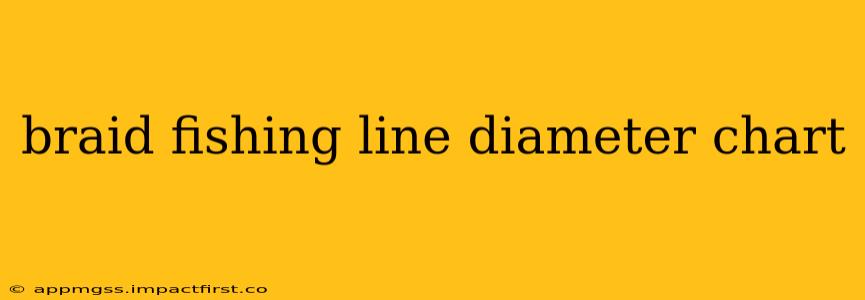Choosing the right braid fishing line is crucial for a successful fishing trip. Understanding the relationship between braid diameter, strength, and application is key. This comprehensive guide provides a braid fishing line diameter chart and answers frequently asked questions to help you select the perfect line for your needs.
While a simple chart showing diameter and pound test is helpful, it's important to remember that different manufacturers use slightly different processes, resulting in variations. Always refer to the specific manufacturer's specifications for the most accurate information. This guide focuses on general trends and information to help you navigate the world of braided line.
Understanding Braid Diameter and Pound Test
Braid fishing line is measured by its diameter, usually expressed in millimeters (mm). The pound test (lb test) indicates the breaking strength of the line. A higher pound test generally means a thicker diameter, offering greater strength and the ability to handle larger fish. However, thicker lines can also be less sensitive and cast further distances, which is something to consider when choosing your line.
Factors Affecting Braid Diameter and Strength
Several factors influence the relationship between diameter and strength in braided fishing lines:
- Material: Different materials used in braiding (e.g., Spectra, Dyneema, PE) affect the line's strength and diameter.
- Construction: The number of strands and the braiding technique influence the line's overall strength and durability. A tightly braided line is generally stronger for its diameter than a loosely braided one.
- Manufacturer: As mentioned, different manufacturers have varying manufacturing processes, leading to subtle differences in diameter and strength for the same pound test.
Frequently Asked Questions (PAA)
This section addresses common questions about braid fishing line diameter:
What is the best braid diameter for bass fishing?
The ideal braid diameter for bass fishing depends on several factors, including the size of the bass you target, the type of cover you're fishing, and your preferred fishing technique. For most bass fishing applications, a 10-20lb test braid with a diameter ranging from 0.10mm to 0.16mm is a good starting point. Lighter braid offers better sensitivity and casting distance, while heavier braid provides more strength to handle larger fish and heavy cover.
How does braid diameter affect casting distance?
Thinner braid generally casts further than thicker braid. The reduced diameter creates less wind resistance, allowing for longer casts. This is particularly beneficial when fishing open water or long distances. However, thinner lines have less breaking strength.
What is the relationship between braid diameter and knot strength?
Knot strength is crucial. While thicker braid generally offers higher breaking strength, knot strength can vary depending on the knot type and tying technique. It is always best to practice your knot tying and learn knots specifically designed for braided lines to minimize line breakage at the knot. This is more critical for thinner braids.
Is it better to use thinner or thicker braid?
There's no universally "better" braid diameter. The optimal choice depends on your fishing situation. Thinner braid is superior for sensitive techniques and longer casts in situations where larger fish are less common. Thicker braid is more suitable for targeting larger fish or fishing in heavy cover where line strength is paramount.
How do I measure my braid's diameter?
Precise measurement requires a digital caliper. However, you can get a reasonable estimate by comparing your braid to a diameter chart provided by the manufacturer. Alternatively, some tackle shops offer measuring services.
Choosing the Right Braid: A Practical Approach
Don't just focus on the numbers. Consider these additional factors:
- Target Species: Different fish require different line strengths.
- Fishing Location: Structure and cover influence line choice.
- Fishing Technique: Some techniques require more sensitivity or strength than others.
- Manufacturer's Specifications: Always refer to the manufacturer's chart for your specific line.
By carefully considering these factors and utilizing this guide, you can select the appropriate braid fishing line diameter for your next fishing adventure and increase your chances of success. Remember, the best braid is the one best suited to your specific needs and fishing style.
